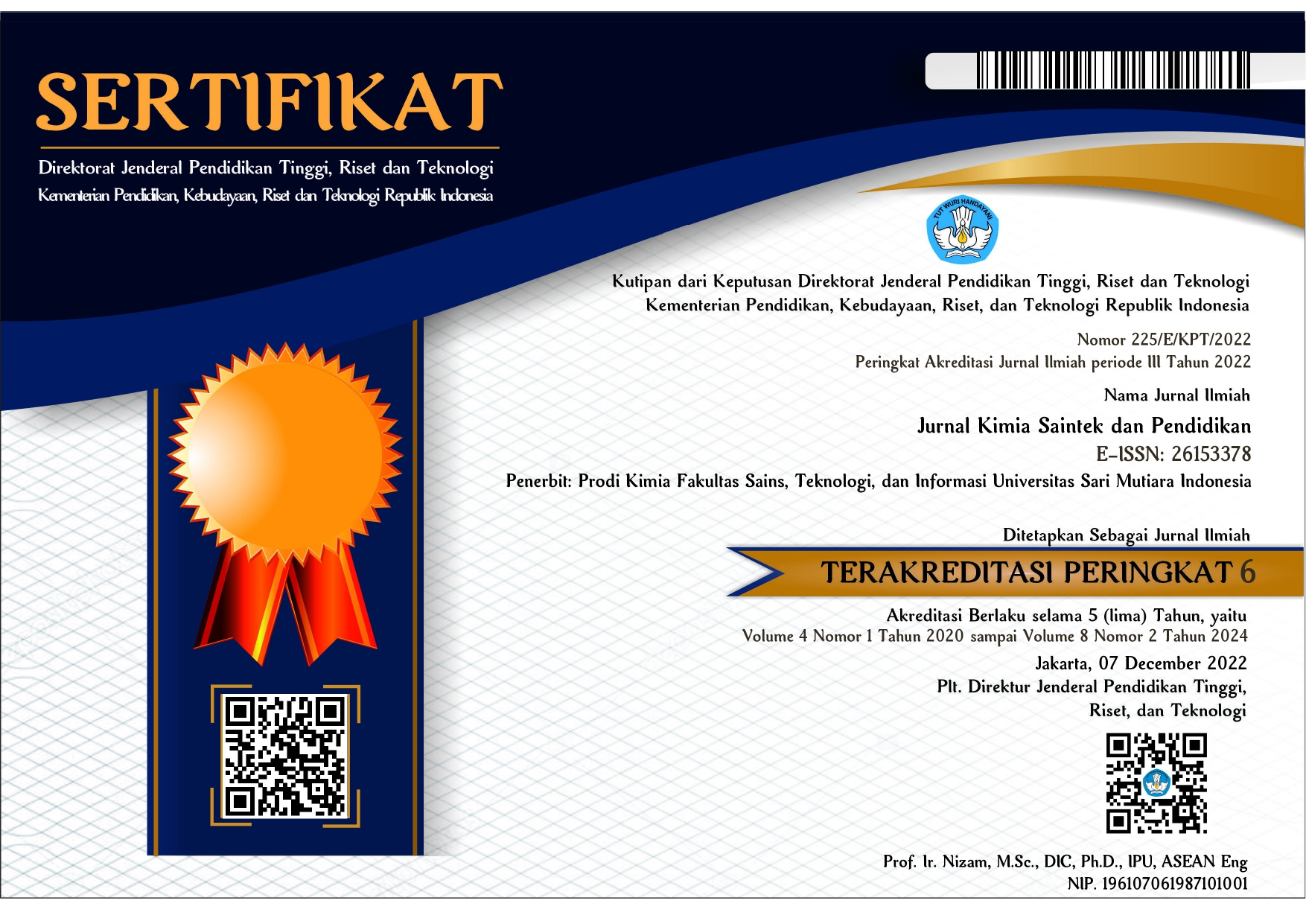ANALYSIS OF HAZARDOUS COMPOUNDS IN REFILLABLE ROLL-ON PERFUMES CIRCULATING IN GORONTALO CITY USING GC-MS
DOI:
https://doi.org/10.51544/kimia.v8i1.5101Keywords:
Refillable roll-on perfumes, Hazardous compounds GC-MS analysis, Gorontalo CityAbstract
This study aims to analyze the potentially hazardous compounds in refillable roll-on perfumes. The analytical method employed was GC-MS. The results from GC-MS analysis revealed hazardous compounds including Alpha-Pinene with concentrations in samples A-E = 0.0048 ppm, 0.0035 ppm, 0.0105 ppm, 0.0038 ppm, 0.0034 ppm; Dipropylene glycol with concentrations in samples A-E = 0.0322 ppm, 0.0162 ppm, 0.0692 ppm, 0.0493 ppm, 0.0465 ppm; Limonene with concentrations in samples A-E = 0.0705 ppm, 0.0373 ppm, 0.0222 ppm, 0.1462 ppm; Linalool with concentrations in samples A-E = 0.0092 ppm, 0.0568 ppm, 0.0146 ppm, 0.1298 ppm, 0.1233 ppm; Linalyl Acetate with concentrations in samples A-E = 0.1207 ppm, 0.0719 ppm, 0.0413 ppm, 0.1418 ppm, 0.1285 ppm. The levels of these compounds in the samples are below exposure thresholds, suggesting their current use is considered safe. However, stringent government oversight is necessary for refillable perfume products available in Gorontalo City.
Downloads
References
G. Ohloff, W. Pickenhagen, P. Kraft, and F. Grau, Scent and chemistry: the molecular world of odors. John Wiley & Sons, 2022.
J. Mensing, “Psychology of Perfume Choice: How We Smell, Who or What in the Brain Decides on the Scent, and Why Perfumes Do So Much Good,” in Beautiful SCENT: The Magical Effect of Perfume on Well-Being, Springer, 2023, pp. 53–80.
C. Barbieri, P. Borsotto, and others, “Essential oils: market and legislation,” Potential Essent. oils, pp. 107–127, 2018.
C. Wambolt, “Exposure to Toxic Chemicals in Consumer Products in the United States,” Ballard Br., vol. 2021, no. 1, p. 1, 2021.
R. Asra, R. Rusdi, P. Arifin, and N. Nessa, “Analisis Senyawa Berbahaya Parfum Isi Ulang Yang Dijual Di Kota Padang Menggunakan Metode Kromatrografi Gas-Spektrometri Massa,” J. Ris. Kim., vol. 10, no. 1, pp. 20–29, 2019.
L. Mondello, A. Casilli, P. Q. Tranchida, G. Dugo, and P. Dugo, “Comprehensive two-dimensional gas chromatography in combination with rapid scanning quadrupole mass spectrometry in perfume analysis,” J. Chromatogr. A, vol. 1067, no. 1–2, pp. 235–243, 2005.
I. Gavris, E. Bodoki, P. Verite, and R. Oprean, “Assessment of perfume ingredients with aphrodisiac potential by gas chromatography-mass spectrometry,” Farmacia, vol. 63, pp. 760–764, 2015.
A. F. Al-Rubaye, I. H. Hameed, and M. J. Kadhim, “A review: uses of gas chromatography-mass spectrometry (GC-MS) technique for analysis of bioactive natural compounds of some plants,” Int. J. Toxicol. Pharmacol. Res., vol. 9, no. 1, pp. 81–85, 2017.
K. Gurning, H. A. Simanjuntak, H. Purba, and others, “Identification of the chemical compound of essential oil from ketumbar (Coriandrum sativum L.) leaves with GC-MS,” Pharmacogn. J., vol. 12, no. 5, 2020.
J. Liu, M. Lin, P. Han, G. Yao, and H. Jiang, “Biosynthesis Progress of High-Energy-Density Liquid Fuels Derived from Terpenes,” Microorganisms, vol. 12, no. 4, p. 706, 2024.
N. T. Program and others, “NTP Technical Report on the Toxicity Studies of o-Phthalaldehyde (CASRN 643-79-8) Administered by Inhalation to Sprague Dawley (Hsd: Sprague Dawley®SD®) Rats and B6C3F1/N Mice,” 2018.
S. T. Cragg, “Glycol ethers: Ethers of propylene, butylene glycols, and other glycol derivatives,” Patty’s Toxicol., pp. 789–878, 2001.
V. H. Adams, “Toxicology Report No. HEF-S. 0059709.14-19, October 2021 Toxicology Directorate Toxicology Assessment for Work Unit SAGE 16-01 Qualification of HAP-free Cleaners for Aircraft and Ground Vehicles October 2019-October 2021,” SAGE, vol. 16, p. 1, 2021.
R. Soulimani, J. Bouayed, and R. K. Joshi, “Limonene: natural monoterpene volatile compounds of potential therapeutic interest,” Am. J. Essent. Oils Nat. Prod., vol. 7, no. 4, pp. 1–10, 2019.
S. Nikfar and A. F. Behboudi, “Limonene,” 2014.
N. S. Dosoky and W. N. Setzer, “Biological activities and safety of Citrus spp. essential oils,” Int. J. Mol. Sci., vol. 19, no. 7, p. 1966, 2018.
L. Caputo et al., “Lavender and coriander essential oils and their main component linalool exert a protective effect against amyloid-$β$ neurotoxicity,” Phyther. Res., vol. 35, no. 1, pp. 486–493, 2021.
S. C. Rastogi, S. Heydorn, J. D. Johansen, and D. A. Basketter, “Fragrance chemicals in domestic and occupational products,” Contact Dermatitis, vol. 45, no. 4, pp. 221–225, 2001.
V. T. Politano, E. M. Lewis, A. M. Hoberman, M. S. Christian, R. M. Diener, and A. M. Api, “Evaluation of the developmental toxicity of linalool in rats,” Int. J. Toxicol., vol. 27, no. 2, pp. 183–188, 2008.
X. Guo and P. Wang, “Aroma characteristics of lavender extract and essential oil from Lavandula angustifolia mill.,” Molecules, vol. 25, no. 23, p. 5541, 2020.
C. S. Letizia, J. Cocchiara, J. Lalko, and A. M. Api, “Fragrance material review on linalyl acetate,” Food Chem. Toxicol., vol. 41, no. 7, pp. 965–976, 2003.
Downloads
Published
Issue
Section
License
Copyright (c) 2024 Indriyanti Ibrahim, Ishak Isa, Opir Rumape, La Ode Aman, Wiwin Rewini Kunusa, Jafar La Kilo, Akram La Kilo

This work is licensed under a Creative Commons Attribution-ShareAlike 4.0 International License.











.png)

